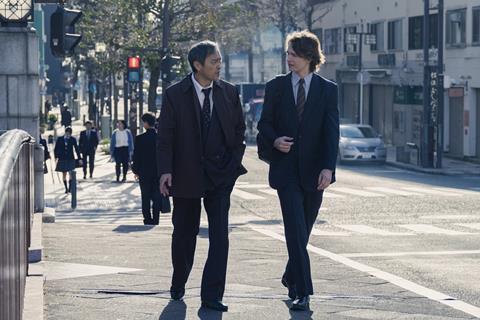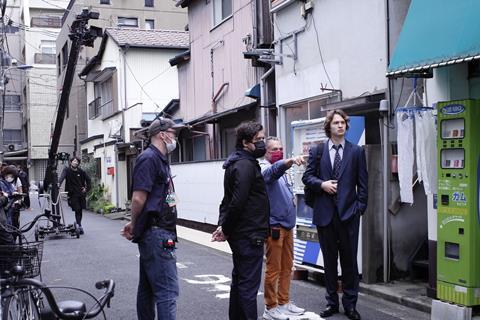
The adage ‘less is more’ was something US cinematographer Corey Walter learned on the job while shooting season two of HBO Max series Tokyo Vice on location in Japan.
“It was more like shooting an indie film to me. An indie film with hundreds of crew,” says Walter. “I didn’t have that many tools because I had nowhere to put them.”
Serendipitously, because the equipment and transportation were all Japanese, they were by necessity smaller than what Walter had used previously. “My lights were really small. Everything was tiny,” which made it work.
Working on productions such as FX miniseries Fleishman Is In Trouble for FX and Apple TV+ drama We Crashed meant Walter was more accustomed to having convoys of semis, trucks and trailers, rigging crews and “many, many lights”. He says being without this bounty of equipment set him on a different path cinematographically.
“Where I could put things was very important,” he explains. “Often there’s no space for any of those [extra] things in Tokyo. It’s so tight.”
It is nearly two years since Tokyo Vice debuted its first episode, directed by Michael Mann, and stars Ansel Elgort as a US journalist at Tokyo’s largest newspaper who investigates the Japanese underworld through his informal partnership with a local policeman, played by Ken Watanabe.
Filming for the second season of the crime drama took place from November 2022 to May 2023, and its 10-episode run launched on streaming service HBO Max last month. It is set to conclude on April 4.
Shooting in Tokyo was unlike anything else Walter had encountered. Unlike other cities, where productions can impose lockdowns on full streets, Tokyo does not yet have the filming infrastructure in place to allow a production to make that request. “In between takes, to shut down the street, to clear everybody out, put in our own extras and do a take, it would take a very long time because there’s just so many people everywhere you go,” he explains.
In particular, the Kabukicho area of Tokyo – an entertainment district known for its hostess clubs and adult-oriented nightlife – is consistently crowded. “It seemed like there were hundreds of thousands of people on the street that you’re trying to move out, so you can get your own people in because we are shooting.”
The production was able to access an international production incentive during its pilot phase, a grant that eased the way for filming. This programme has now been replaced by a full location incentive managed by the Ministry for Economy Tourism and Industry (METI), with the aim of attracting international features, high-end TV and streaming projects to shoot in Japan.
In addition to Kabukicho, Tokyo Vice, led by showrunner JT Rogers and co-produced by US-based Fifth Season and Japan-based WOWOW, shot in locations throughout the city including in some of the most notoriously difficult areas such as Akasaka and Shinjuku, among others.

Creativity out of challenges
“Learning on the fly” was key for Walter, balanced against the multitude of regulations, managed by a variety of different local police precincts. These relationships took time to foster and were maintained throughout production by a team of location managers, including supervising location manager Masanori Aikawa.
“I would have a big crane with lights on and they’d need to be in a very specific spot, and we’d only learn on the day that we couldn’t put something there,” he says.
What Walter found was a ‘grey’ area, ensuring they abided by regulations but allowing for more flexibility by working with the Tokyo Film Commission on location to find spots that they could use in the moment.
In addition, Tokyo Vice is a period piece, taking place in the 1990s, so there were anachronistic elements they had to avoid getting in the frame, while making sure his equipment remained in their permitted spots.
What the seasoned cinematographer found was that the challenges presented him with a new creative impetuous. “All of those restrictions strip down your process to the core of what it is that you really are trying to do,” he says. “Sometimes, by stripping all the things away, you come up with a more creative, more interesting, or more compelling shot.”
The sheer volume of people in the city meant almost all the driving scenes were filmed in Tokyo’s Toho Studios. There, an LED volume wall built by technology firm Hibino Corporation was brought in. This alleviated the pressure on an already inflexible production schedule, given the strict location permits.
For Walter, having an LED wall to shoot driving sequences was a “game changer”, not just for Tokyo Vice but for future international productions looking to shoot in the city. “If you build it, they will come,” he says of the technology. According to Mitsuru Shimada, president of Toho Studios, the LED volume wall remains available for use by productions in future.
However, Walter does not advocate the use of LED walls to replace filming in Tokyo itself. A location shot in Shinjuku in particular features a ride down a glass elevator overlooking the city. “Yes, you could do that from plate shots in virtual production, but there’s a flatness to it,” he says. “You don’t get the depth of that actual view.”
When Walter first met with executive producer and director Alan Poul, they discussed how one of the main characters of the series was Tokyo itself.
Filming extensively on the streets of the city was a departure from the show’s first season, whose production made extensive use of Toho Studios due to Covid-19 pandemic restrictions in place at that time.
For season two, Walter says the team wanted to “take this out of the studio and put it on the street or somewhere on location, so we can feel Tokyo more”.
Should a third season go ahead, Walter wants to film further outside Tokyo and is optimistic about the ways production will change. The challenges of finding space for a camera and navigating the throngs of people, even with the language barrier — overcome thanks to bilingual ADs and “the language of film” as Walter calls it — were “fun” ones.
“I would always shoot in Japan, I love it,” he adds. “The more productions go there, a lot of these challenges I’m talking about will iron themselves out.”

























No comments yet